INTRODUCTION
The prevalence of feeding problems has been estimated to be from 33% to 80% in children with developmental disorders [
1,
2]. Feeding and swallowing disorders during childhood are increasing. They typically occur in conjunction with multiple and complex medical and developmental conditions [
3,
4]. Approximately 37% to 40% of children assessed for feeding and swallowing disorders were born prematurely at less than 37 weeks of gestation [
5,
6]. Increased survival rates of children with histories of prematurity, low birth weights, and complex medical conditions might explain the recent increase of pediatric dysphagia [
7].
Swallowing is a dynamic process. Videofluoroscopic swallowing study (VFSS) is generally considered as a reliable and safe method to evaluate dysphagia in pediatric population [
8]. Nonetheless, the procedure exposes children to radiation. In addition, it provides only a brief sample of swallowing performance which can be an unpleasant and frightening experience for some children. Increased use of VFSS in the pediatric population has led to queries regarding the overuse of VFSS in evaluating swallowing difficulties [
9]. The benefits from the use of the test should be weighed against its risks, particularly if its use involves infants. Therefore, before considering a VFSS referral, a review of medical, developmental, and feeding history should be conducted to comprehensively evaluate children with dysphagia.
At present, standard clinical assessment tool for pediatric dysphagia has yet to be validated. Indicators have not been established to determine when a VFSS is necessary. Consequently, evaluating the severity of dysphagia is more challenging in children than in adults. Moreover, there is little understanding on the characteristics of children with severe dysphagia, especially those with etiologies other than neurologic disorders. The purpose of this study was to evaluate demographic data of children with suspected dysphagia referred for VFSS, including age, prematurity, underlying medical conditions, reason for referral, and diet status at the time of the study to identify clinical factors related to penetration or aspiration confirmed by VFSS.
Go to :

DISCUSSION
The objective of the present study was to identify the demographic characteristics and clinical factors related to penetration or aspiration in children with dysphagia who underwent VFSS. About 50% of the children in this study were less than 24 months of age, which corresponded well with the results of an earlier study by Rommel et al. [
6]. The reason for the percentage of children younger than 24 months of age might be the essentiality of feeding for survival in those age groups. In this study, penetration or aspiration was observed in more than 70% of subjects with dysphagia who were younger than 24 months of age, which was similar to the penetration or aspiration rate of 74.8% in infants with swallowing difficulty reported by Uhm et al. [
15]. However, Lee et al. [
16] and Mercado-Deane et al. [
17] reported aspiration rates in infants at 17% and 52%, respectively, which were lower than the rate in the present study. The discrepancy could be due to the difference in study populations. This study included subjects from a tertiary hospital where there are a large number of critical patients with serious underlying medical conditions.
In addition, premature groups were more likely to show penetration or aspiration in univariate analysis, especially those born earlier than 34 weeks' gestational age. This fits well with the fact that coordination of sucking, swallowing, and breathing is established at 34 weeks of gestation [
18]. However, prematurity was not significantly associated with aspiration in multivariate analysis. Of the 62 patients with prematurity history, 44 (71%) were younger than 2 years, 25 (40%) had CNS disease, 22 (35%) had miscellaneous disease, 12 (19%) had congenital disease, 3 (5%) had neuromuscular diseases. Ninety-two percent of premature patients performed VFSS at the corrected age of 4 months and older, indicating that most patients had dysphagia for a perceptible time. There is a high probability that aspiration of prematurity was influenced by other factors, including underlying medical conditions and age.
The results of this study demonstrate that CNS disease, especially brain tumor, is the most common underlying medical condition in children with dysphagia. Lefton-Greif [
13] and Love et al. [
19] reported that cerebral palsy was the most frequent neurologic condition associated with dysphagia in children. Rommel et al. [
6] reported gastrointestinal problem was the most frequent medical diagnosis of children presenting feeding problem in a tertiary care center. The difference between our result and results by others could be explained by high ratio of critical patients in our hospital.
In multiple logistic regression analysis, patients with miscellaneous underlying medical conditions were more likely to show penetration or aspiration in VFSS. Miscellaneous conditions included various heart diseases (n=9, 3%), gastroesophageal reflux disease (GERD) (n=16, 5%), post-intensive care condition (n=3, 1%), and unknown causes. Infants with congenital heart disease are at risk of potential dysphagia, secondary to postoperative vocal cord dysfunction [
20]. Patients with GERD often show aspiration pneumonia, masquerading oropharyngeal dysphagia. GERD can also occur in conjunction with laryngeal dysfunction or swallowing incoordination [
17]. Patients with prolonged intubation are at increased risk of dysphagia mostly reported in adults [
21]. Endotracheal tube can cause remodeling of palate due to pressure of the tube on the hard and soft palate [
22]. Despite several tests, 16 subjects failed to reveal the exact cause of dysphagia. This group needed continuous consultation and periodic follow-up of changes in dysphagia. Patients with dysphagia of unknown cause need further research.
For all age groups except for infants younger than 6 months, aspiration symptoms or signs were the major causes of referral for VFSS. In patients younger than 6 months, poor oral intake was the primary cause of referral for VFSS. This finding correlated well with the results of Newman et al. [
5] who reported that infants were less likely to show aspiration symptoms such as cough due to anatomical structures. However, our study showed higher penetration or aspiration rates during VFSS in younger age groups. This suggests that younger children without aspiration symptoms or signs can have silent penetration or aspiration which can be revealed by VFSS. The existence of silent penetration or aspiration displays the usefulness of VFSS in children with underlying medical conditions with ambiguous symptoms of dysphagia [
8]. However, VFSS findings should be interpreted and integrated with other information, including feeding history, underlying medical conditions, and nutritional status. A physical examination including posture and position of feeding, respiratory pattern, alertness, response to sensory stimulation, self-regulation ability, oral structure, and growth should also be conducted. In addition, symptoms, such as vomiting, coughing, choking, drooling, wet voice, and feeding observation, must be included. Children are very sensitive to taste, texture, and temperature of food [
23]. Therefore, using subject's usual meal for VFSS can change the result of the study, especially in those with poor oral intake.
There were several limitations to this study. First, this was a retrospective study. Second, the study was a single-center study. Therefore, referral bias might be an inherent consequence. In addition, a high ratio of preterm infants with variable underlying medical conditions was used in this study.
In conclusion, the results of this study showed that penetration or aspiration was more often observed (approximately 70%) in children younger than 24 months of age. The penetration or aspiration rate was higher in those born prematurely at less than 34 weeks of gestation. Underlying medical conditions causing dysphagia differed by age group. This study revealed that younger children born prematurely are at higher risk to develop feeding disorders. Therefore, performing VFSS is beneficial for these children. The findings from this study will improve our understanding on the usefulness of VFSS in children with dysphagia of unknown etiology, particularly for those younger than 24 months with a history of preterm birth.
Go to :






 PDF
PDF ePub
ePub Citation
Citation Print
Print


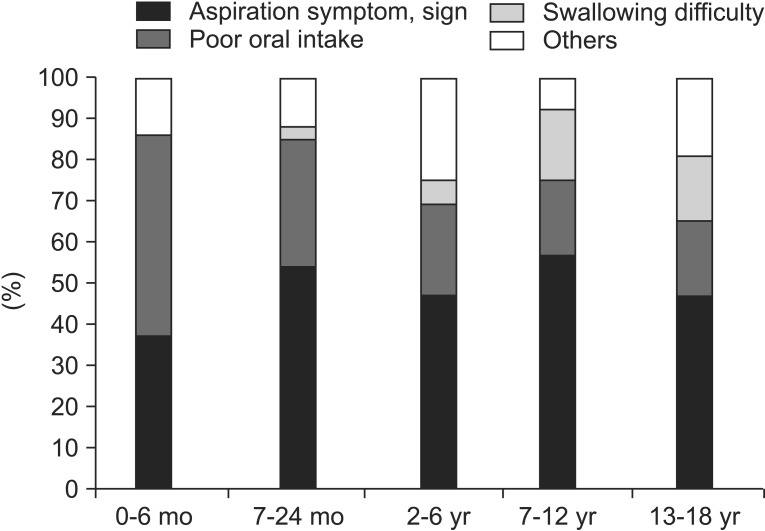
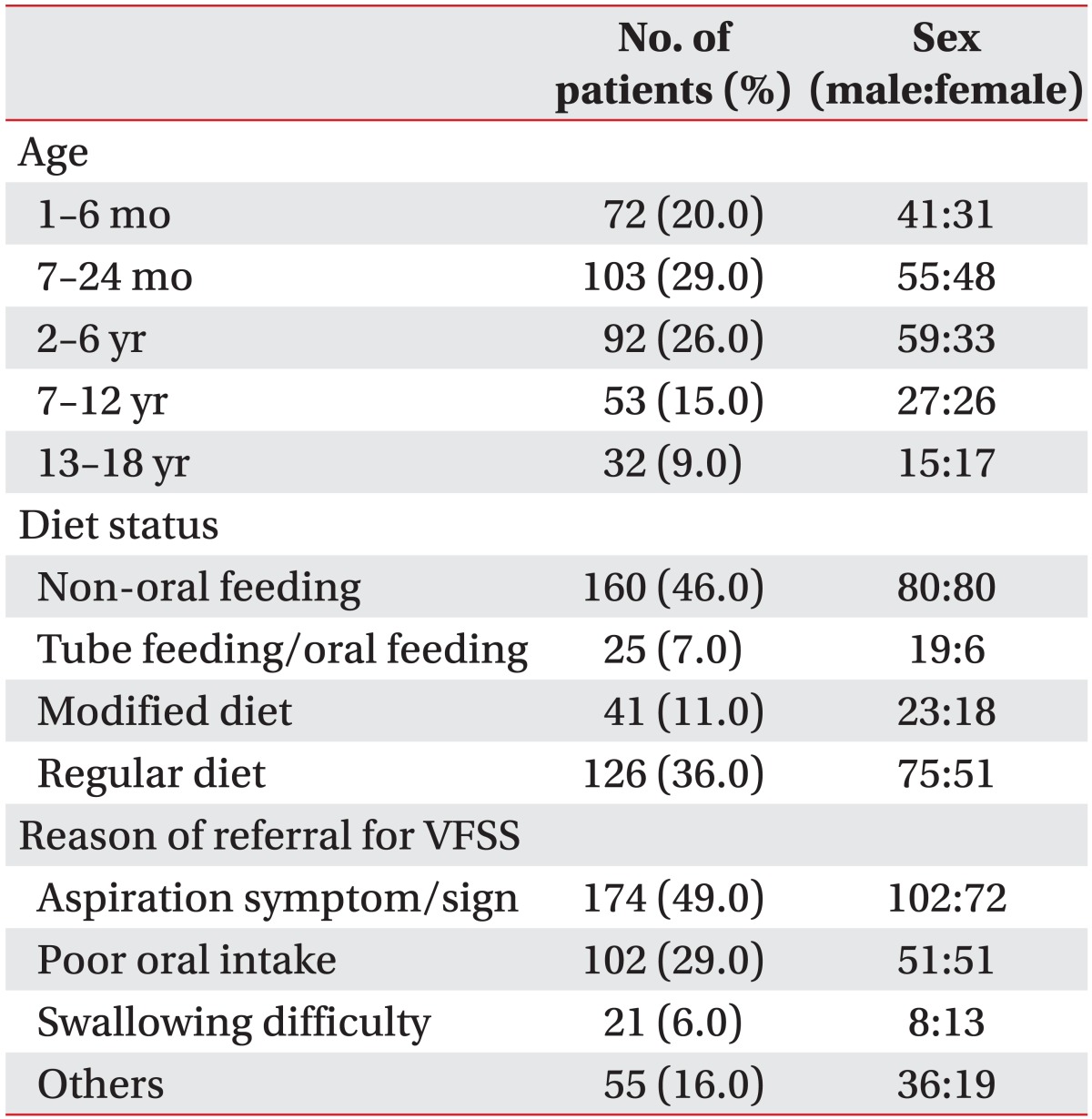
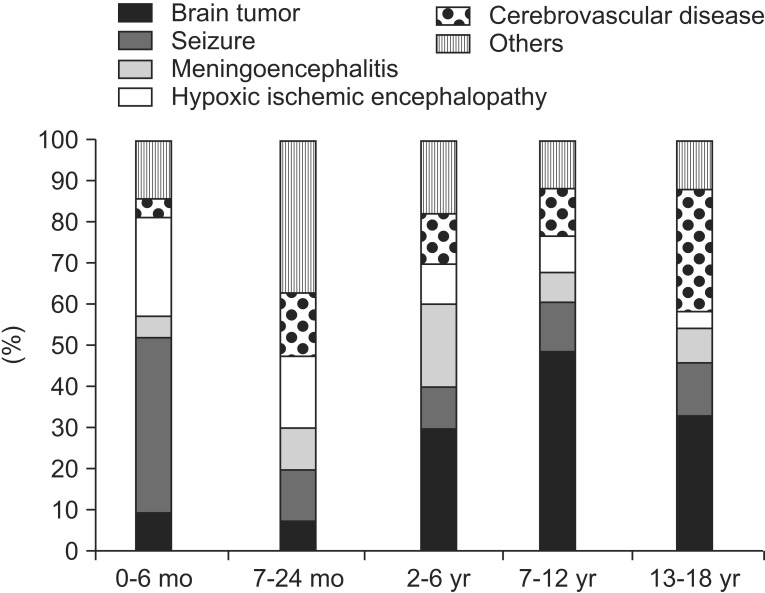
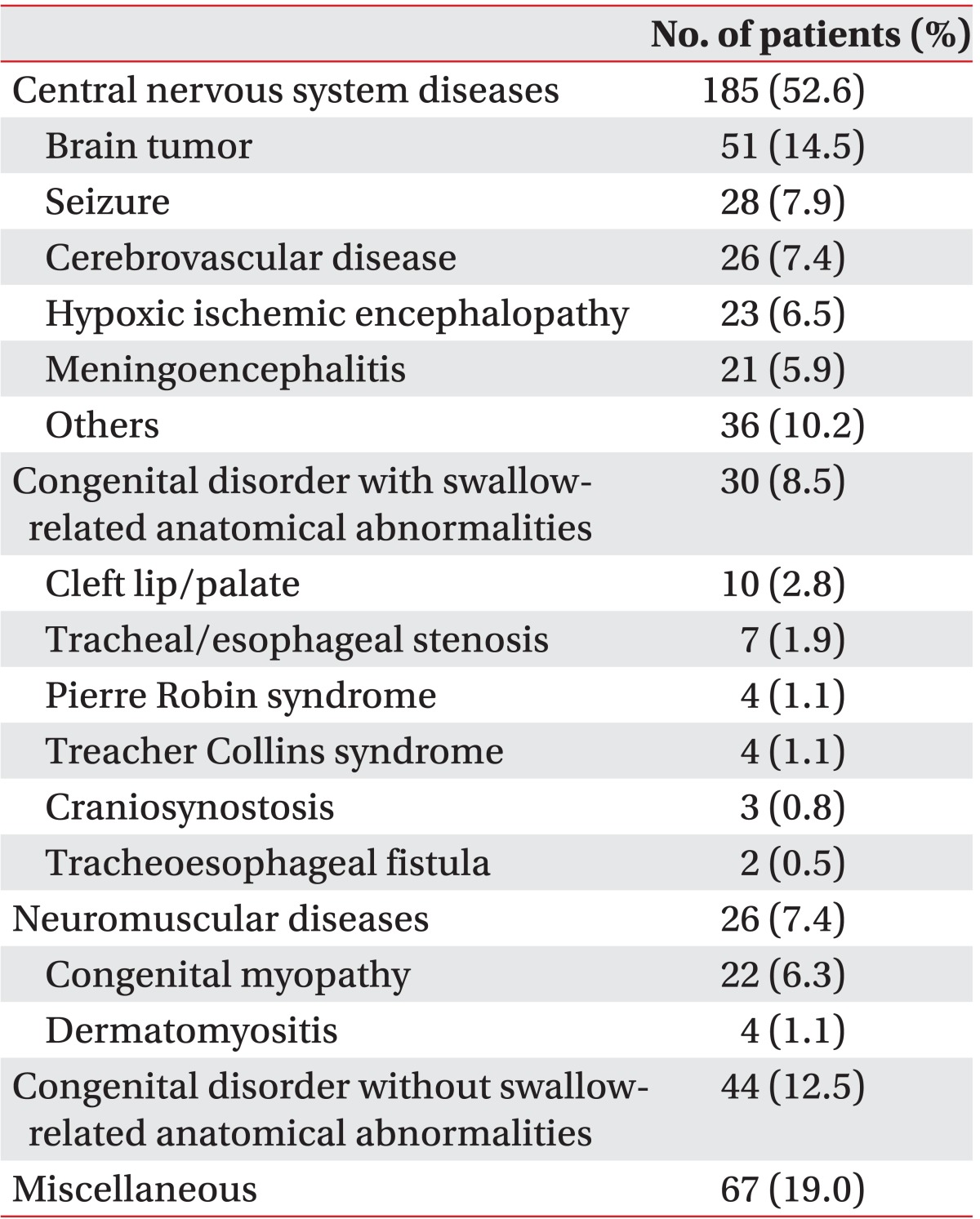

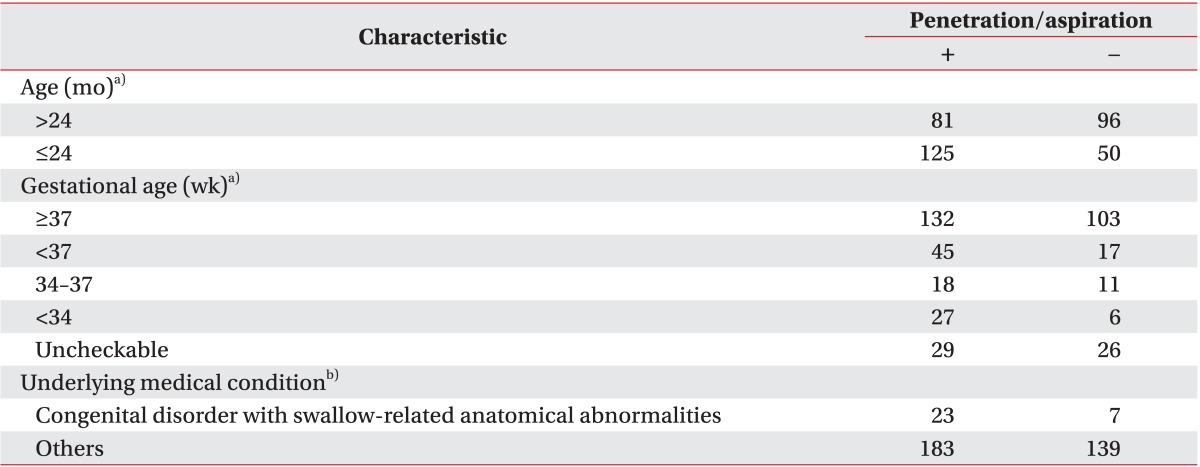
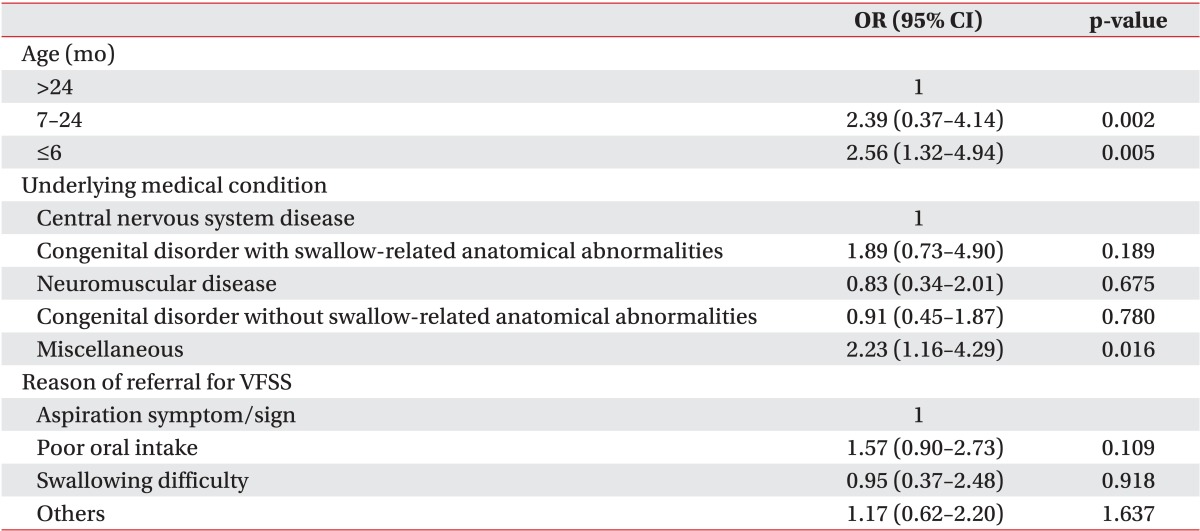
 XML Download
XML Download